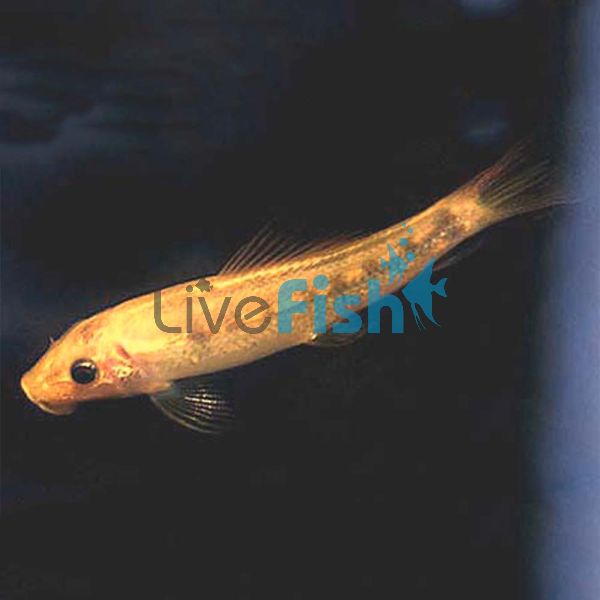Gold Sucking Catfish 5cm
The sucking catfish is one of the first clean-up crew species that aquarists will be exposed to. These fish are usually the size of a toothpick in aquarium stores and the way they latch onto the glass and scrub it clean is super adorable to watch. These however are actually not catfish at all and are a member of the loach family. The sucking loach as they should rightfully be called is an incredibly hardy, easy to care for, cold water tolerant species that sounds like it would be great for any aquarium however as these fish mature, they can often be a burden if they are not in the right type of aquarium.
Gold Sucking Catfish
The sucking catfish is one of the first clean-up crew species that aquarists will be exposed to. These fish are usually the size of a toothpick in aquarium stores and the way they latch onto the glass and scrub it clean is super adorable to watch. These however are actually not catfish at all and are a member of the loach family. The sucking loach as they should rightfully be called is an incredibly hardy, easy to care for, cold water tolerant species that sounds like it would be great for any aquarium however as these fish mature, they can often be a burden if they are not in the right type of aquarium.
Sucking catfish reach a maximum size of around 12 cm and get surprisingly thick. They also tend to become quite aggressive once they pass the 7-8 cm mark and in smaller beginner aquariums which is what these fish are often kept in, they can be incredibly territorial. They do however look almost identical to a Siamese algae eater and whilst standard-sucking catfish have, a unique and wild look, through selective breeding over the decades these fish have been in the aquarium hobby we also have the gold-sucking catfish. This would have to be one of the brightest-coloured bottom-dwelling fish in the aquarium hobby with a solid bright yellow colour from head to tail. Whilst as juveniles these fish are great algae eaters when they mature, they tend to prefer a meatier diet and their care could be compared to that of a slightly more aggressive bristlenose pleco.
They are however incredibly easy to care for and can even be kept in outdoor ponds all year round as a clean-up crew member with no issues. Breeding these fish isn’t that common in the home aquarium but these are captive-bred. Generally, golden sucking loaches are bred in outdoor ponds but in the home aquarium, some high protein foods, fast flow, and PH along with temperature fluctuations may trigger them.
Tank Recommendations for your Golden Sucking Catfish
Golden-sucking catfish max out at around 12 cm and due to their territorial behaviour, an aquarium with a minimum volume of 100 liters will be required. They are not concerned with the choice of substrate but will really appreciate an abundance of hardscapes in the aquarium. By giving them a range of driftwood, pipes, and caves, it may diffuse any aggression due to the visual breaks. Having a well-planted aquarium can accentuate this as well.
Suitable Tank Buddies
As long as these fish aren’t kept in small systems, they are quite tolerable of most tank mates. Due to their adaptability in water parameters and temperature, they can be kept with both tropical and cold-water fish.
Usually Compatible
Corydora, bristlenose plecos, geophagus, goldfish, and other preferably larger or trouble-free tank mates.
Sometime Compatible
When these fish are fully grown it is best to try to avoid keeping them with slow-moving nano fish such as neon tetras. Discus, angelfish, severum, and other large-bodied and slow-moving fish have been reported to have their slime coat being eaten by the golden-sucking catfish at night.
Rarely Compatible
Shrimp and large aggressive species such as African cichlids, Oscars, and Jaguar cichlids.
Feeding your Golden Sucking Catfish
Though golden-sucking catfish are sold to beginners for their algae-eating behaviour this is not their only diet. Without added supplementation in their diet, they will begin to starve and show higher levels of aggression which is why they should also be fed a varied diet of pellets, flakes, and frozen and insect-based live foods. Because of their primarily bottom-dwelling mentality a slow sinking food is best fed to them as this also allows other water column tank mates to eat as well.
| Scientific Name | Gyrinocheilus Aymonieri |
|---|---|
| Care Level | Easy |
| Common Names | Golden Sucking Catfish, Golden Sucking Loach, Chinese Golden sucking loach, Golden Cleaner Loach, Asian Golden Sucking Catfish |
| Diet | Omnivore |
| Fish Family | Gyrinocheilidae |
| Lifespan (years) | 6 |
| Max. Length (cm) | 12 |
| Min. Tank Volume (l) | 100 |
| Origin | Southeast Asia |
| Reef Safe | Yes |
| Sociability | Semi-aggressive |
| Venomous | No |
| Water Conditions | 15-28° C, pH 6.0 - 7.5 |




